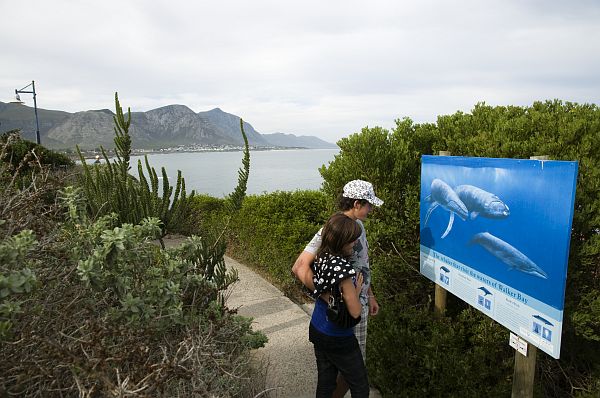

At the southern tip of Africa, where two of the world's greatest oceans converge, a total experience of land, sea and the rainbow culture of the Western Cape offer you the most exciting land based whale watching venues in the world!
Each year Southern Right Whales migrate into the coastal waters of the Western Cape to calve and nurse their young. The animals, often mere metres from the shore, provide unsurpassed whale watching opportunities between August and November.
Humpback Whales migrate through the region between May and December each year, while Brydes Whales are found slightly further offshore all year round.
Accommodation areas from which to observe these gentle giants on the Cape West Coast include:
Spot these enormous creatures from lookout points at various points in the Cape Peninsula, but spesifically on Boyes Drive (traces the mountain side from Muizenberg to Kalk Bay) and Clarence Drive (coastal road between Gordons Bay and Rooi Els on to Betty's Bay).
At Hermanus the Whale Cryer informs on whale sightings and where whales come into the old harbour to calve.
Whales can be viewed further along the coast:
On the Garden Route whale viewing can be done at Stilbaai - where the Southern Rights enter the placid water to bear their calves - Gouritzmond, Vleesbaai, Dana Bay, Mossel Bay - especially on the St Blaize's hiking trail - Hartenbos, Great Brak River, Ballot's Bay, Herold's Bay and Victoria Bay.
At Wilderness the viewing is good especially from Dolphin's Point on the Kaaiman's Pass - and further along the coast at Sedgefield, Knysna - especially from Brenton-on-Sea and Knysna Heads - and Plettenberg Bay.
Plettenberg Bay offers a "whale hotline" and where whales often come in close, especially at Keurbooms River and beaches, as well as Robberg Peninsula.
There are 78 species of whales and dolphins world wide, of which 37 are found in Southern African waters. These species can be divided into two main types, namely the baleen whales (including the Southern Right Whale, Humpback and Bryde's Whale) and the toothed whales (including the Sperm Whale, Killer Whale, Beaked Whales, Dolphins and porpoises).
Baleen whales use horny plates in their mouths (baleen or whalebone) to strain food (minute plankton or krill) from the water, while the toothed whales generally feed on fish or squid.
Whales tend to show of in the following manner:
A sound made when expelling air through the blowhole. This is accompanied by a spout of condensed water vapour. This however is the normal breathing pattern of the animal.
Leaping out of water in an arching back flip and falling back on their sides or back with a resounding slap. This is believed to be a way of communication, exercise or possibly to scratch the parasites off that live on whales. They can breach form 3 to 8 times in succesion.
The slapping of flukes and tail on the water, causing a loud sound, appears to be a means of communication.
The head and body are lifted vertically, as far as the flippers, above the surface. This enables them to see what is happening around them above water.


